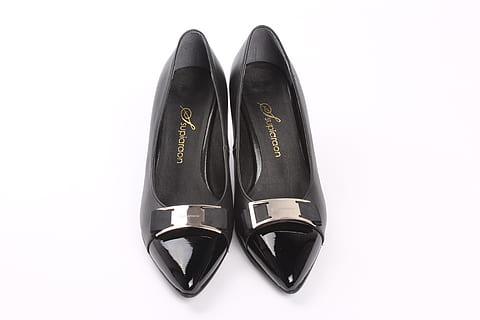(Read Part 1 of, “Do Your Eyes Buy Your Shoes?” here)
It is vital to know your foot shape

It is important to fit the shape of your foot with the toe box shape of the shoe. A foot with a taper toe shape will fit best in a pointier toe box shoe. These shoes are considered stylish and seem to be in demand for a dressier look but the foot with a straight, squared, or splay-toe shape will not be comfortable in a taper-toed shoe. Simply put, you can’t put round pegs in square holes and expect it to fit comfortably. Something has to give and it’s usually the level of all-day comfort that is compromised. Deformities will occur over time causing a wide range of bio-mechanical difficulties and shoe fitting issues. The most common reason for general foot pain and discomfort is ill-fitting footwear.
3. Know what type of shoe you will need. Will it be truly for exercising or general daily wear. If it is truly for engaging in an exercise program what type of exercise will you be doing? Today’s athletic shoes are designed with all different types of movement in mind and it’s important to get a shoe that will work best for that purpose. As for casual shoes and dressier footwear, the most important thing to consider is the quality and construction of the shoes. The firmer the footwear the better the long term comfort. Most people would think the softer the better but that does not add up to all-day comfort. Remember, firmer is better because your feet are your foundation and a foundation is made of firm material. It may take a bit of time to “break-in” the shoes but once they are seated to your feet or broken-in properly they will feel superior to any softer shoe. The heel height is also important. When a foot sits inside a shoe that has more than a 2-inch heel the foot becomes unable to function. The high heel position puts the foot into a locked state and reduces motion which over-time can cause dysfunction and/or deformities of the foot. Shoes with heels that are 2’’ and lower are healthier and more comfortable long term.
4. Get your size checked yearly. As we age our feet change, just like everything else about our bodies. Proper foot sizing should be done on a Brannock Device. Designed in 1927, The Brannock Device® foot-measuring tool is a must in all retail footwear stores and the best way to measure your feet. This device measures the length of the toes, the length of the arch, as well as the width of a foot. Brannock measuring devices are the standard in the footwear industry. However, the arch length and the width are the 2 most important measurements to have for a comfortable fit. Start with the arch length size for picking your shoes and place the ball of the foot or the big toe joint in the spot in the shoe where the arch ends and the toebox begins. Please know that most shoes made today come from China. Chinese manufactured footwear usually runs small, so you must go up ½ to 1 full size for a proper fit. If the shoe fits at the arch but the width seems to be sloppy don’t buy a smaller shoe. Either try a lesser width fit or simply add a toe filler into the toebox to make the width or toebox space smaller. A toebox filler can be something as simple as a 1/8’’ to 1/4’’ piece of sheet cork cut to fit in the toebox of the shoe. If the shoes are made in Portugal, Germany, Italy, Spain, or the United States (yes, some are still made here) these shoes are usually more true to size. It’s just the truth about shoes made today. Most athletic shoes are made in China so always go up in size when buying this type of footwear. Remember this rule will almost guarantee a more comfortable fit. Fitting this way allows the shoes your eyes like to also be comfortable. You can download our free shoe fitting guide at: https://walkezstore.com/shoe-fitting-guide/.
(Stay tuned for part 3 and you’ll be happy as can be.)


